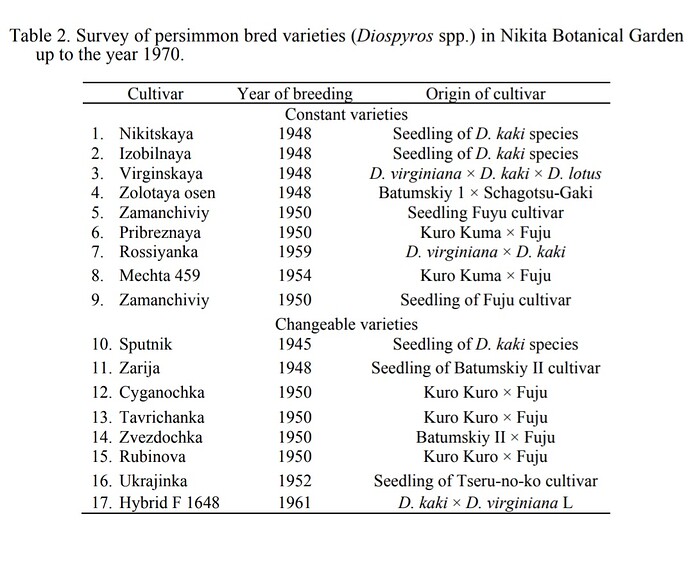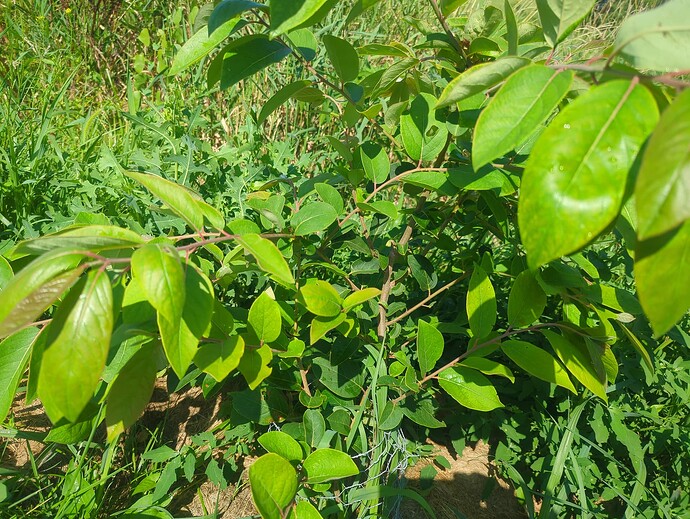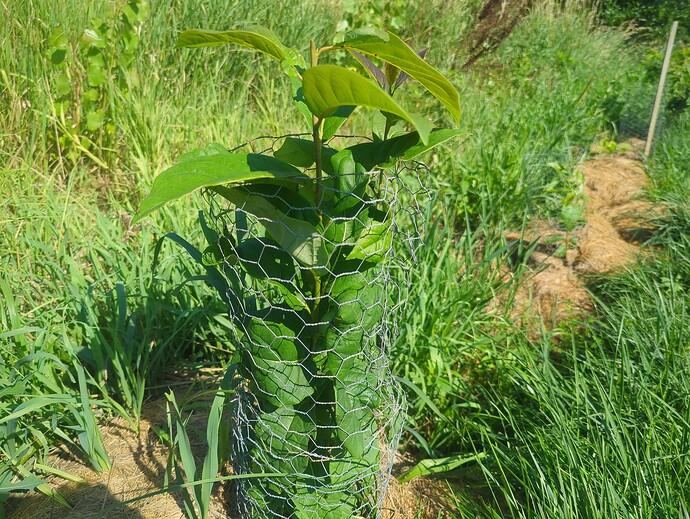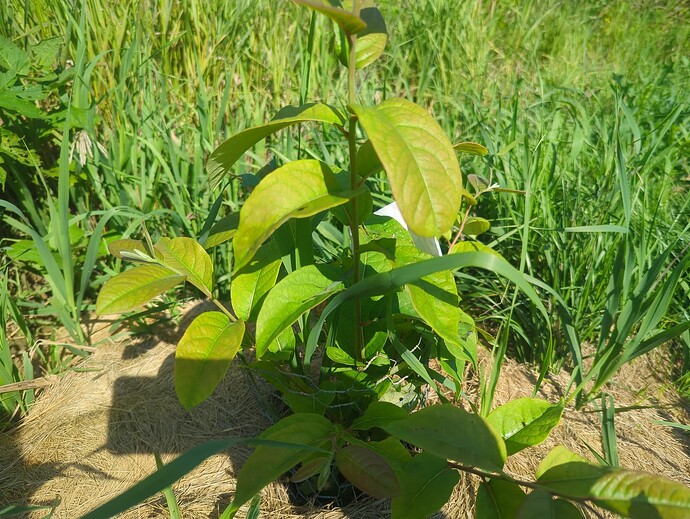Highly recommend this article https://www.researchgate.net/publication/324542348_Persimmon_collection_in_Nikita_Botanical_Gardens_its_history_and_practical_use
" Persimmon collection in Nikita Botanical Gardens; its history and practical use
- March 2018
- Acta Horticulturae 1195(1195):23-28
DOI:10.17660/ActaHortic.2018.1195.4
Authors:
- Nikita Botanical Gardens
“The first (unsuccessful) introduction of persimmon in Nikita Botanical Gardens was in 1819. Later, in 1901 a small plantation was established using nursery plants of 10 persimmon cultivars from France. This plantation was the starting point for introduction of persimmon in the Crimea. The collection was enriched in 1937, when the Department of Subtropical Crops was founded at Nikita Botanical Gardens. Today the collection consists of 87 cultivars and genotypes of three botanical species: Diospyros kaki Thunb., Diospyros virginiana L., and Diospyros lotus L. The best cultivars of Nikita Botanical Gardens were obtained as a result of inter-species and intra-species crossing. The detailed study of this germplasm allowed us to classify the persimmon cultivars and select the most favorable ones by their horticultural characteristics (productivity, fruit quality, and resistance to diseases). The evaluation of cultivar suitability for environment and management styles is described. © 2018 International Society for Horticultural Science. All Rights Reserved.”
@harbin said this " i have found this picture of A.K.Pasenkov - a creator of the first hybrid Rosseyanka back in 1958."

In this we discussed the true history of hybrid persimmons but not in full details Hybrid Persimmons that are reportedly cold hardy
"Start from the beginning Rosseyanka aka Russian Beauty is a 50% hybrid.
Rosseyanka persimmon was bred from (Diospyros virginiana x Diospyros kaki) 50/50. Rosseyanka Persimmon trees are an extremely cold hardy Russian hybrid crossed with an American native Persimmon… Rosseyanka persimmon was one of the first cross breeds of American persimmon Diospyros virginiana persimmon and the Asian Kaki persimmon.
@Harbin has said before a number of years ago
“Rosseyanka originated in 1959 by Pasenkov at the Nikitsky Botanical Garden. He crossed a seedling no.213 of American Persimmon (female) with pollen of Asian Persimmon forms 48 and 145. A hybrid no. 18 has been grown up in vitro (laboratory conditions)and fruited in 1964 for the first time. It was named “Rosijanka”. That’s the story.”
Englands says this
" Rosseyanka Hybrid - Persimmon of exceptional quality and the large size which in near a 3 inch persimmon that ripens late and is very delicious we have been growing this selection for Approx. 20 year or so and We have never been disappointed with the crops of Luscious fruit that looks like Orange Orbs when the tree looses the leaves and the fruit remains on the trees. Reminiscent of Dio. Virginiana our native persimmons but Suitable for Zone 5 and very hardy down to about -18 degrees it is one of our favorites here our orchards."
In this thread Rosseyanka is rightly called a 50% hybrid aka F1
@stan says this "No, it does not. Rosseyanka translates as “a Russian woman” or, formally, “a female citizen of Russia”. россиянка - Wiktionary
Unfortunately, it’s common in the US plant trade to replace “difficult” foreign variety names by anglicized versions, like Russian Beauty instead of Rosseyanka or Nikita’s Gift instead of Nikitskaya Bordovaya. This often creates some confusion."
Im going to take a minute an reference this thread
Nikita’s Gift™ Hybrid Persimmon is from the Nikita Botanic Garden in Yalta, Ukraine, this unique hybrid of Asian and American Persimmon bears bountiful crops of sweet and flavorful, reddish-orange fruit followed by strikingly beautiful, orange-yellow fall foliage. Nikita’s Gift™ Hybrid Persimmon grows 10-12 ft. in height, is self-fertile and hardy to minus 10 °F.
This is an f2 hybrid NG dropped fruits the first 2 years. Nikita’s Gift is a seedling of Rossyanka X Kaki. Nikita’s Gift in my understanding is 75% kaki, and 25% virginiana. Remember its mother
Rosseyanka is 50% hybrid but now crossed back with kaki means Nikita’s Gift is 75% kaki.
@tonyOmahaz5 spoke with Jerry Lehman as shown below.
"was amazed that my NG has seeds and sought answers from Jerry Lehman.
Jerry,
I am a little puzzled why one of my Nikita’s Gift fruit had 2 seeds and I have no Asian male persimmon. The only other Asian persimmon that had fruit for the last 2 years was Ichi Kei Ki Jiro. I tested the seeds by placing them in a glass of water and they sank to the bottom and that showed me that they are viable. I placed the seeds in the frig and will plant them in pots next spring. Could NG has male flower? Thx
Hi Tony,
Nikita’s Gift (Nikitskaya Bordovaya) is a intraspecies hybrid of American X kaki. Most such hybrids produce few viable seeds. And when they do it can be by either of the hybrid’s parent’ species.
The seeds from your tree are most likely N. G. x virginiana. There is a very very remote possibility it is apomictic, but all my trees from seeds from Rosseyanka and Nikita’s Gift are very different, therefore almost assuredly back crosses to virginiana.
I have never seen any male flowers on either of my Rosseyanka or Nikitskaya Bordovaya trees.
Jerry"
See also
"Hybrid Persimmon
Interspecific hybrids of Diospyros virginiana and Diospyros kaki
Rosseyanka / Rossiyanka - First hybrid persimmon
PARENTAGE: no. 213 D.v. × form 48 or 145 D.k.
BREEDER: A.K.Pasenkov, 1958
HARDINESS: -13F
Nikita’s Gift / Nikitskaya Bordovaya
PARENTAGE: open pollinated seedling of Rosseyanka
BREEDER: Oleksandr Kazas, 1975
HARDINESS: -10F
JT-02 (Mikkusu)
PARENTAGE: Josephine D.v. x Taishu D.k.
HARDINESS: -22F
FLAVOR:
Kasandra
PARENTAGE: Great Wall D.k x Rossey 2
HARDINESS: -16F
FLAVOR: Many people report it being their favorite tasting persimmon cultivar. Brix 21
Holds fruit until picked
Ripens at the same time as JT-02
NB-02 (Zima Khurma)
PARENTAGE: Nikita's Gift × Taishu
HARDINESS:
FLAVOR:
Dar Sofiyivky / Gift of Sofiyivka - earliest hybrid
PARENTAGE: Kolhospnytsia D.k. × D.v.
HARDINESS: -20F
FLAVOR:
Gora Roman Kosh / Mount Roman Kosh
PARENTAGE: Nikita's Gift x open pollinated
HARDINESS: -8F
FLAVOR:
SOURCES: Scouring the internet + growingfruit.org/t/list-of-hybrid-persimmon-species-available-in-usa"
If Kolhospnytsia D.k. × D.v. is Dar Sofiyivky parents and N.G. is the grandparent at 75% kaki
That would make the parent 100% american x 75% kaki.
See this thread from @harbin
@JustPeachy did a good job in this post
quote=“JustPeachy, post:8, topic:40372”]
In the hybrid progeny from free pollination of the ‘Kolhospnytsia’ cultivar with the American persimmon D. virginiana in the genealogy, a new cultivar ‘Dar Sofiyivky’ has been selected. It combines increased winter hardiness with good fruit quality, early fruit production and early ripeness.
Source .
[/quote]
See this link
https://www.palomar.edu/anthro/mendel/mendel_2.htm
See this link
http://mchr.sofievka.org/article/view/219810
" Dar Sofiyivky’ as a new Ukrainian cultivar of persimmon (Diospyros L.)
Authors
- Vasyl’ Derev’ianko
- Ivan Kosenko
- Anatoly Opalko
- Nataliia Derev’ianko
DOI:
https://doi.org/10.37555/2707-3114.16.2020.219810
Keywords:
adaptation, plant hypobiosis, global warming, winter hardiness, interspecific hybridization, persimmon cultivars.
Abstract
Aim. Creation of new domestic persimmon cultivars (Diospyros spp.) adapted to the soil and climatic conditions of Ukraine will contribute to the introduction of new fruit plants into the industrial horticulture that combines high productivity and fruit quality, enriches the assortment of food products and improves the components of rational alimentation. Methods. Field studies of the persimmon species, cultivar and form collection, hybridization and station testing of hybrid seedlings have been conducted in the orchards of State Enterprise Experimental Facility “Novokakhovska” of Institute of Rice of the National Academy of Agrarian Sciences of Ukraine (Kherson region). In vitro seed germination of and two-year hybrid persimmon seedlings growth has been carried out in the Department of Genetics, Breeding and Reproductive Biology of Plants of the National Dendrological Park “Sofiyivka” of the National Academy of Sciences of Ukraine. The rest of the experiments and data statistical analysis have been done using generally accepted methods in breeding. Results. Advantages of D virginiana L. in hybridization with D. kaki Thunb. to increase the persimmon adaptability to unfavorable wintering factors have been confirmed in the extreme temperature conditions of the winters of 2005–2006 and 2011–2012. In the hybrid progeny from free pollination of the ‘Kolhospnytsia’ cultivar with the American persimmon D. virginiana in the genealogy, a new cultivar ‘Dar Sofiyivky’ has been selected. It combines increased winter hardiness with good fruit quality, early fruit production and early ripeness. In 2019, the cultivar ‘Dar Sofiyivky’ has been included in the State Register of Plant Varieties suitable for distribution in Ukraine. In vitro technologies have been used in the tissue culture laboratory of the “Sofiyivka” Dendrological Park for germination of interspecific hybrids seeds, which have insufficient germination in the field. A initial hybrid seedling has been obtained, from which the ‘Dar Sofiyivky’ genealogy is derived. Conclusions. Horticultural plant breeding, in particular persimmons (Diospyros spp.), in areas with ecologically different contrasting conditions within the framework of a single program to increase the adaptability of plants and the quality of fruits is promoted to accelerate breeding and expand the northern border cultivation of thermophilic fruit crops."
Lets review what we know and try to figure out the correct percentages.
@jrd51 the parent according to my research is Kolhospnytsia.
1.Rosseyanka = DV x DK f1 =50%
2.Nikita’s Gift = f1x DK = f2 =75%
3.Kolhospnytsia = f2×DV=f3
4.Dar Sofiyivky =f3 x dv = f4"
What about.Rosseyanka aka Russian beauty tests in the USA
https://uncommonfruit.cias.wisc.edu/american-persimmon/
" Cultivars tested
‘Meader’ and ‘Russian Beauty’
Description and site preference
Type and size – large, 30-75 feet if not pruned
Hardiness zone – 4-9
Exposure – full sun in northern areas
Soil – wide range but warm, sandy preferred
Drainage – all but waterlogged areas
Economic factors
Years to harvest – 3-5 for grafted stock
Maintenance – emphasis on pruning
Life of planting – 50-75 years
Machine harvest potential – none (needs multiple hand harvests)
Suitable markets – fresh and processed

American Persimmon, with fruit, after leaf fall
Notable features
Nutritional highlights – contains vitamin C and calcium
Adaptability – good in most locations
Pest issues – rare, but can be susceptible to anthracnose
Invasive potential – native
Environmental benefits – deep tap root makes it a good dynamic accumulator, late blooming sustains pollinators
Integration characteristics
Shared management – intermediate, similar to most other fruit trees
Shared equipment – pruning
Shared processing – low, needs specialized harvesting and handling
Co-marketing – low to intermediate, needs special handling for fresh fruit
Integration potential – some
Could be a good stand alone crop but would also provide ecological diversity in an integrated system
History and background
The genus name for persimmon literally means “Fruit of the Gods.” Two species of persimmon (Diospyros) have significance as fruit crops: The kaki, or Asian persimmon, was the most widely grown fruit in East Asia until the 20th century. The American persimmon was relished by Native Americans, but has never been embraced as a commercial fruit crop because many cultivars are too soft for commercial shipping. These species are similar in many ways, but the American persimmon is more cold-hardy, with some cultivars hardy to Zone 4 (though ripening can be a problem). It is also softer and dryer than the kaki, but has a richer flavor. American persimmon is also higher in nutrients like vitamin C and calcium.
The following describes the American (Virginiana) variety, unless specified otherwise.
Persimmon trees are usually dioecious (either male or female), but some have complete flowers that make them self-fruitful. They are somewhat unique in that sexual expression can vary from year to year. Trees remain dormant longer than most fruit trees, and blossoming is relatively late in the season and rarely damaged by late-spring frosts.
American persimmon are high in soluble tannins until they are thoroughly ripe. Unripe fruit is extremely astringent, but throughly ripened fruit is sweet and delicious (though some may not like the soft, pudding-like texture). Persimmons can be eaten fresh, dried or cooked into pies, cookies and cakes. Native Americans used them in gruel, cornbread and pudding.
As the name suggests, American persimmon is a native fruit. Its native range is New England to Florida and west to Texas, Louisiana, Oklahoma and Kansas. Kaki has had centuries of improvement through breeding, but American persimmon has had very little breeding attention. Most of the named cultivars are chance seedlings. There is much room for cultivar improvement through selective breeding.
Observations at Carandale Farm
Carandale Farm ordered the cultivars from One Green World in 2006.
The ‘Meader’ cultivar was selected for observation because it was said to be the only available American selection that is reliably self-fertile. It is also one of the most cold-hardy, surviving to at least -25 degrees F, and adapted to regions with cool summers. Fruit ripens early but looses it astringency slowly.
- Both trees of this cultivar adapted well, though one has surpassed the other in vigor and fruitfulness.
- Trees have shown no sign of disease or insect damage.
- Trees reached a height where it is difficult to pick top fruit with a 10-foot ladder. Pruning will be done to restrict height.
- Trees survived -31.6 degrees F in January 2009, three years after transplanting, with no visible signs of winter injury. (This was the coldest temperature recorded by an on-site weather station since the test plot was established in 2003.)
- Persimmon is somewhat hard to transplant because it has a brittle tap root.
- One of the trees started fruiting in 2010 and had a branch-bending crop in 2011.
- Trees were still in dormancy in 2012 when most other fruit trees in the test plot were in full bloom. When the majority of fruit was lost by freeze damage on many other fruiting species, the late bloom on the persimmon trees avoided freeze damage.
- Variability was high between two trees of the same cultivar at the same site. One came into bearing much earlier and has always ripened its fruit on the tree. The second tree was slow to fruit, and the fruit was still unripe late in the season. (This may even out over time, but they almost look like two different genotypes.)
- Fruit can be hard to remove unless very ripe and soft. Multiple harvests are required because some fruit is very soft and sweet, while others remain hard and astringent.
- For this cultivar (or at least for this one tree), fruit tends to hang on the tree even when dead ripe.
- This variety obviously has bi-sexual bloom (both stamen and pistol) or produces both male and female flowers because the fruit are never seedless.
‘Russian Beauty’, the second cultivar tested, is a hybrid of kaki and American persimmon. This hybrid is supposed to have the winter hardiness of the American and the quality of the kaki. Carandale Farm established two plants, but one was delayed because it had to re-bud from the scion wood.
- Both trees passed the winter hardiness test of -31.6 degrees F.
- Foliage is distinctly different from the ‘Meader’ cultivar.
- The larger tree was covered with bloom for the first time in 2012, after six years.
- There was no fruit set. Timing of bloom was a little after ‘Meader.’ Lack of fruit set was probably not weather-related.
- It is suspected that the blooms were all male, but this was not confirmed. As the tree matures it may produce female flowers, which is often the case with persimmon.
- It will probably be a couple of years before the second tree comes into bloom.
Discussion
Carandale Farm is close to the northern limit of existing American persimmon cultivars. They cannot recommend it as a reliable, economically sustainable fruit crop for similar areas, but they see potential for this fruit to be grown and marketed in Zone 4. Renewed interest in breeding programs for this native American fruit could push cultivation farther north and improve fruit quality (size, seediness and texture). Climate change could also expand the northern limit.
Kaki, or Asian persimmon, could also be grown in areas north of Zone 6 through selective breeding and hybridization with American persimmon. As Lee Reich said in Uncommon Fruits for Every Garden, “Imagine what years of breeding could do for persimmons by comparing a diminutive, puckery, wild apple with a perfectly grown MacIntosh.”
Educating the public will help make the American persimmon economically sustainable in the future. Fully ripened fruit can be sweet and flavorful, but its soft texture and seediness can be a hard sell to those who think a fruit has to be firm (which has been promoted by our globalized food system).
Even in its current state, the American persimmon has qualities that could make it an attractive addition to an integrated cropping system. In northern regions, it should have full sun to accelerate ripening, but it could be inter-planted with low-growing bushes and shrubs. It tolerates almost any soil, except those that are waterlogged, and is virtually insect- and disease-free. Its long taproot should make it a good dynamic accumulator, which would benefit other species. If planted next to nitrogen fixing plants, the symbiotic relationship could lessen the need for outside sources of fertility.
American persimmon could be successful in a local/regional marketing system with a short supply chain. Until improved selections are found, it will probably be best as a stand-alone fruit crop for local retail sales. Anyone interested in pursuing American persimmon as a profitable fruit crop should experiment with a number of selections to find out what works best in their meso-climate. With the selections currently available, American persimmon seems to be an inconsistent fruit, varying in ripening time and quality, from region to region and even from year to year.
References
Wikipedia entry on Persimmon
USDA Nutrient Data Laboratory: Native Persimmon
Tree Trail
Uncommon Fruits for Every Garden, by Lee Reich
This article was posted in Uncommon fruit.
"












